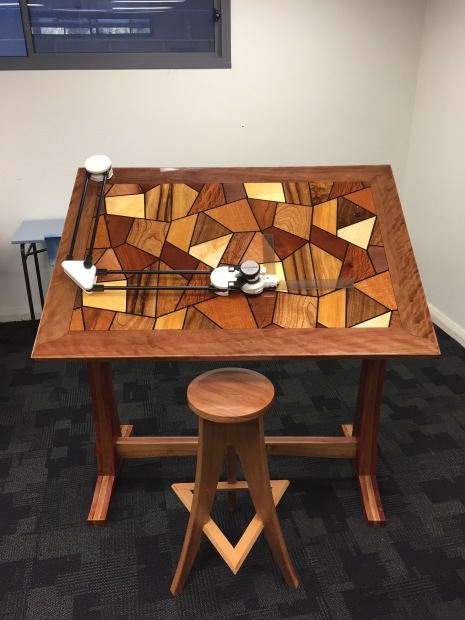Jasmine Wellings, Drafting Table and Stool (Student Awards 2017)
AWARDED BEST USE OF NATIVE TIMBERS 2017 Drafting Table and Stool Date of making: 2017 HSC major industrial technology project Materials used: - Australian hardwoods including: • Red iron bark • Black but • Brush box • Rose wood • Cypress Pine • Northern Silky Oak • Southern Silky Oak • Red Cedar • Huon Pine • Coachwood • Blackwood • Forest Oak • Crows Ash • Jarrah • Celery Top Pine - Stainless steel tilting mechanism and pegs - Zinc plated steel bolts, nuts and washers Dimensions: - Height: 960 - Width: 887 - Length: 1260 Photographer: myself and Michael Wellings For my industrial technology HSC major work, I decided to design and construct a drafting table and stool fit for use by an architect or designer. The table is adjustable by the stainless steel tilt mechanisms to various angles to be used while seated and horizontal to be used while standing. I used a wide range of tools, equipment and machines to cut, shape and finish many individual components. A major part of the project involved the preparation of many components starting with big, heavy slabs of rough sawn Australian hardwood. The main focal point of the drafting table is the parquetry table top which consists of over 63 individual tiles pieces made up of 13 different types of Australian hardwoods. I used a black pigmented resin to fill the gaps and applied the glass finish resin on top. For the legs and rails of my design I laminated contrasting Australian hardwoods together to produce the thickness I wanted and used through mortise and tenon joints with locating pins. I used face plate turning technique to create the stool seat and a half lap joint for the rails of the stool. The culmination of all of the process have contributed to the successful completion of a very functional piece of equipment, which is also a very aesthetically pleasing piece of furniture. Jasmine Wellings, Year 12, St Peters Catholic College Tuggerah. Teacher: Mr Wellings






Images have been resized for web display, which may cause some loss of image quality. Note: Original high-resolution images are used for judging.


